The evolving media landscape offers an invaluable lens through which we can understand the interconnected nature of politics, technology, and culture. As the world adjusts to a new U.S. administration under President Donald Trump, significant developments have emerged, reshaping public discourse and revealing deep-seated global implications.
TikTok’s Ban: A Prelude to Change
The digital realm has been a focal point of transformative shifts, with TikTok’s temporary ban (and reinstatement) serving as a significant early marker of the incoming administration’s priorities. The Protecting Americans from Foreign Adversary Controlled Applications Act placed the popular social media app in the spotlight, requiring its Chinese parent company, ByteDance, to divest U.S. operations by January 19. ByteDance’s failure to meet this deadline led to TikTok becoming temporarily inaccessible, with alerts within the app warning users of its impending suspension.
President Trump’s subsequent executive order granted a 75-day extension for negotiations, signaling an openness to resolve national security concerns while retaining the platform’s accessibility. This back-and-forth highlighted the administration’s emphasis on technological sovereignty and security.
During the momentary ban, American TikTok users turned to alternative platforms, notably RedNote (known as Xiaohongshu in China). This migration revealed the interconnectedness of global digital ecosystems and underscored the resilience of user communities.
RedNote and Cross-Cultural Exchanges
The influx of American users to RedNote sparked a fascinating cultural exchange. Traditionally a lifestyle platform, RedNote became a new space for shared experiences, with users engaging in dialogues about cultural practices, daily life, and even collaborative language learning. Tutorials created by Chinese users helped newcomers navigate the app, fostering mutual appreciation.
However, this migration also exposed the stark differences between American and Chinese content moderation policies. Strict censorship on RedNote led to the removal of posts deemed politically sensitive, prompting broader discussions about freedom of expression and platform governance.
This phenomenon serves as a microcosm of the challenges and opportunities inherent in global digital interactions. For businesses and individuals alike, it emphasizes the need for adaptability and awareness of differing regulatory landscapes.
Trump’s Executive Orders: Setting the Tone
While the TikTok saga unfolded, President Trump’s administration began implementing a series of executive orders that underscored its policy direction. These decisions, spanning military, economic, and social arenas, provide a blueprint for the administration’s priorities:
Military Policies and Personnel Changes
- Reinstatement of Service Members: Over 8,000 military personnel dismissed for refusing the COVID-19 vaccine were reinstated, with full back pay. (Business Insider)
- Border Security: Troops were deployed to the U.S.-Mexico border to combat illegal immigration, narcotics trafficking, and human smuggling. Mexican drug cartels were also designated as terrorist organizations. (NPR)
Policy Reversals and New Initiatives
- Climate and Energy Policies: The U.S. exited the Paris Climate Accord, and a national energy emergency was declared to boost domestic production. (CNN)
- Immigration Reforms: A national emergency was declared at the southern border, with plans to end birthright citizenship for children of non-citizens and unauthorized immigrants. (BBC)
- Diversity and Inclusion: Diversity, equity, and inclusion programs across federal agencies were ended, with policies reinstating recognition based on biological sex rather than gender identity. (Wall Street Journal)
Pardons and Legal Actions
- January 6th Pardons: Approximately 1,500 individuals convicted in connection with the January 6th Capitol riot were pardoned, including key figures from extremist groups. (AP News)
Economic Measures
- Trade Policies: While immediate tariffs on Canada and Mexico were not imposed, there are indications they may begin February 1st. Additionally, trade agreements are set for review to prioritize American workers. (Reuters)
Broader Implications and Opportunities
The dynamics surrounding TikTok and RedNote reflect broader trends of digital adaptation and resilience. They highlight the importance of maintaining engagement across platforms and anticipating shifts in user behavior. Similarly, the administration’s swift policy actions demonstrate how government decisions can reshape industries and public discourse.
For media professionals, these developments underscore the value of proactive media monitoring and strategic planning. Staying attuned to these changes enables a more nuanced understanding of the interconnected forces shaping our world.
The AI Race and Geopolitical Shifts
While the TikTok and RedNote transitions exemplify the global digital realignment, another transformative shift is unfolding in real-time—the race for artificial intelligence dominance. A recent AI breakthrough from China has further reshaped the technological and geopolitical landscape, signaling a new era of competition akin to the Cold War space race.
Despite U.S. sanctions restricting China’s access to advanced semiconductors and AI chips, Chinese researchers successfully developed a high-performing reasoning model using fewer resources, lower costs, and alternative processors. This achievement not only challenged existing assumptions about AI development but also sent shockwaves through global markets—initially wiping out $600 billion from NVIDIA’s stock value before its recovery.
However, the implications extend beyond financial volatility. This development underscores critical national security risks, the acceleration of unregulated AI advancements, and the geopolitical ramifications of AI leadership shifting beyond U.S. control. Reports indicate that Deepseek, the lab behind this breakthrough, used OpenAI’s ChatGPT as part of its training process, raising concerns about intellectual property security, data exposure, and potential AI espionage.
AI, National Security, and Global Risk Monitoring
The rapid expansion of AI capabilities necessitates closer monitoring of three key areas:
- Geopolitical AI Rivalries: The U.S. and China are now in a full-scale AI arms race, where regulatory barriers, cybersecurity measures, and intellectual property protections will shape the future of technological dominance. How nations respond to AI leadership shifts will influence economic policies, corporate strategies, and diplomatic relations.
- Security & Espionage Risks: The revelation that Chinese AI developers leveraged OpenAI’s systems in their training process underscores the growing risk of AI-related espionage. As AI models become more advanced, securing sensitive data and restricting unauthorized access will become paramount.
- Market and Industry Disruptions: Just as TikTok’s ban prompted a rapid shift in platform usage, the AI industry is poised for unexpected shifts in power and profitability. Companies that fail to anticipate global AI developments may find themselves at a disadvantage, while those proactively monitoring these trends can position themselves as industry leaders.
The Broader Implications for Business and Media
This AI milestone serves as a reminder that global technological advancements are deeply interconnected with political, economic, and security considerations. Just as the Trump administration’s executive orders reshaped industries and public discourse, AI breakthroughs will force businesses and governments to adapt to new realities—whether through strategic investments, risk mitigation, or policy shifts.
For media professionals, policymakers, and business leaders alike, staying ahead of these rapid developments is no longer optional—it’s essential. The intersection of AI, national security, and regulatory oversight will define the next era of global competition, requiring proactive monitoring, strategic adaptation, and informed decision-making.
Bridging Understanding Through Media & Analysis
Examining these media cycles and technological advancements reveals an opportunity to deepen our understanding of politics, technology, and culture. The TikTok-RedNote phenomenon underscores the importance of digital adaptability, as businesses and individuals must anticipate shifts in user behavior and regulatory landscapes to maintain engagement across platforms. Similarly, President Trump’s executive orders highlight how swiftly policies can reshape industries, national security, and public discourse—reinforcing the need for proactive media monitoring and strategic communication.
Now, the rapid acceleration of AI development and global competition adds a new layer of complexity to this evolving landscape. The recent AI breakthrough from China—achieved despite U.S. semiconductor restrictions—signals a geopolitical shift in technological dominance. The AI race between the U.S. and China is not just about innovation but also about national security, economic power, and control over the next generation of intelligence systems.
By identifying underlying patterns and emerging trends—from social media migration to AI-powered geopolitical shifts—we equip ourselves with the tools to navigate an ever-changing media and technology landscape and contribute meaningfully to critical discussions.
A Call to Engage, Adapt, and Lead
As thought leaders, understanding current events and technological advancements empowers us to engage meaningfully in conversations about change. The AI race, much like the shifting social media landscape and policy-driven economic transformations, demands informed perspectives and strategic foresight.
Adopting an objective, data-driven approach fosters confidence and clarity in navigating uncertainty. Through collective insight, adaptability, and proactive monitoring, we can prepare for the future together—one nuanced observation at a time.

